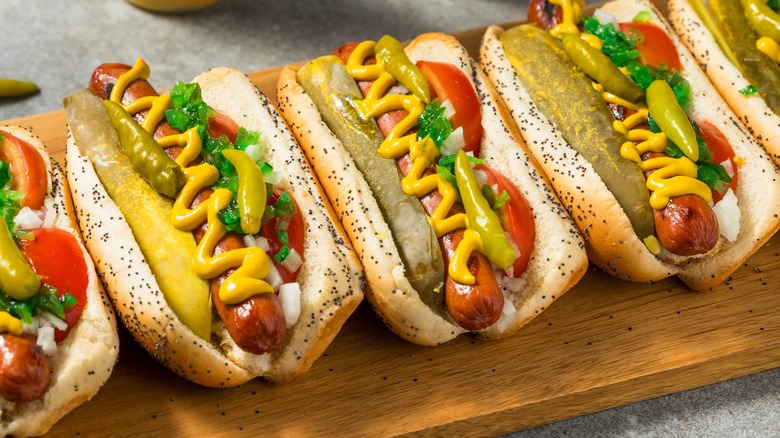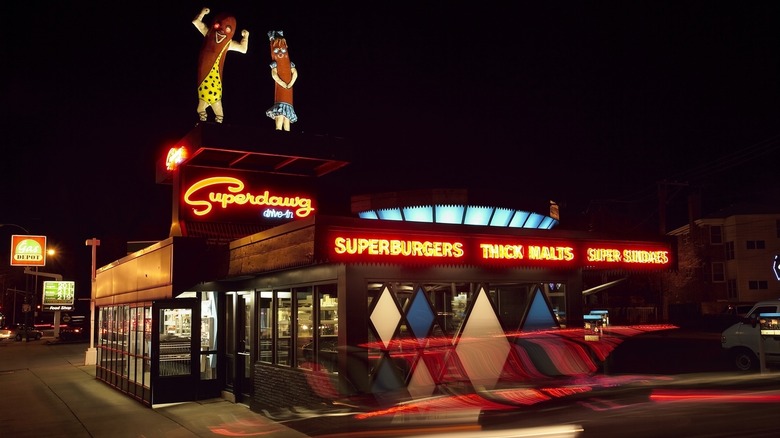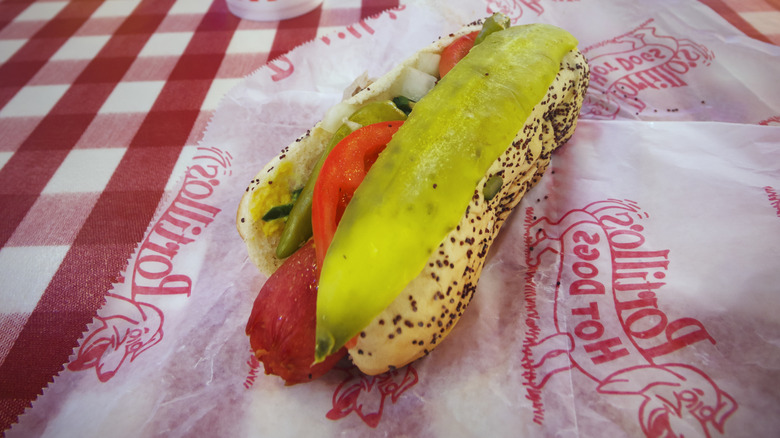How The Chicago-Style Hot Dog Was Born
The Chicago-style hot dog has become a staple of The Windy City. Not surprisingly, this dish's rise to fame is steeped in Chicago's rich history. You may have found yourself wondering where hot dogs come from, and how they became so popular. As hot dog historian Dr. Bruce Kraig told CNN Travel, the dish didn't make its way to America until the 1840s, when German immigrants brought their cuisine across the Atlantic. However, Chicago's unique hot dog style was developed during the Great Depression, even earning the nickname "Depression Sandwich" (via Block Club Chicago).
Hot dogs were already a popular working-class food prior to the Depression, but by adding an array of vegetable toppings (including lettuce) to the inexpensive sandwich, Chicagoans could enjoy something close to a full meal for only a nickel. During this difficult financial moment in American history, fries or a drink would not have been offered along with the hot dog to keep costs low. It is out of necessity that the delicious, toppings-loaded Chicago dog was born.
With Jewish immigrants popularizing the kosher-style hot dog in the early 1900s, the Chicago-style hot dog is an all-beef frankfurter in a poppy seed bun. The dog is then topped with yellow mustard, pickle relish, chopped white onion, tomato slices, a slice of dill pickle, pickled sport pepper, and celery salt ... note the absence of ketchup. Packed with vegetables and flavor, the Chicago-style hot dog remains popular almost 100 years after its creation.
The Chicago-style hot dog's salad days
As loaded with history as it is with flavor, a Chicago-style dog is piled with vegetables and is often jokingly said to have been "dragged through the garden." After so many years of being artfully crafted, there are a particular set of rules around how to properly prepare a Chicago dog. A classic Chicago dog's bun will always be steamed — forget toasting– and while the sausage may be boiled or steamed, it will never be grilled. (Some Chicago restaurant owners have broken from tradition by serving slightly burnt wieners called "char dogs.")
Despite being popularized during the Great Depression, consumption of the Chicago dog carried on long after economic recovery. Part of the food's long-term success is credited to the boom of post-war America. Many veterans returning home from World War II moved to the suburbs and discovered that the hot dog cart business was a good way to make a living. From there, the food's popularity has only grown. In fact, the regional specialty has become so popular that restaurants across the country serve some of the best Chicago-style hot dogs money can buy.
The story of the Chicago-style hot dog is written all over the Windy City. In fact, many of its most popular brick-and-mortar hot dog restaurants started out as food carts, such as Superdawg. Wherever you go in Chicago, you're never far away from the history that shaped a hot dog near and dear to the city's heart.
The Chicago-style hot dog today
With so much history behind it, the Chicago-style hot dog continues to thrive. Of course, while the distinct flavor of a Chicago dog remains consistent, some things about Chicago's culinary landscape have changed. For one, America's immigrant population has grown, and newcomers bring with them their own culinary traditions. Now, certain Chicago dog restaurants also offer items on their menu from other parts of the world.
Al's Drive-In, for example, is a popular hot-dog stand just outside of Chicago that offers hot dogs, as well as Chinese food. At this family business, you can enjoy a double hot dog on a classic Vienna all beef hot dog and a chicken chop suey. This blending of cultures is a terrific catalyst for the creation of new and exciting foods.
A modern take on the Chicago dog can also be seen as celebrity chefs share their favorite ways to prepare the food. Chef Matty Matheson can be seen praising the Chicago dog in his Facebook cooking tutorial on how to make them. "We love a city that loves hot dogs," said Matheson.
One thing that has remained the same throughout the Chicago dog's lifespan is the pride it inspires in Chicagoans. The Chicago dog is a symbol with deep ties to its namesake, popularized in the form of souvenirs and even tattoos. Chicago's love for its hot dog is woven into the fabric of the city. In simple terms: It's not going anywhere.


